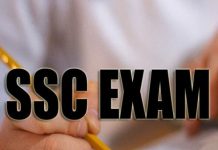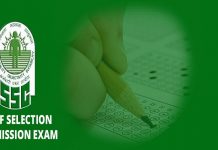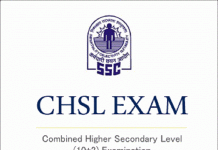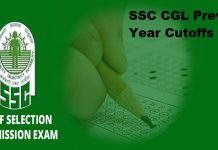SSC CGL 2016 Tier II Exam Pattern
Dear SSC CGL Aspirants,
As SSC CGL 2016 (Combined Graduate Level) Tier I exam is over now and many of you are demanding the Exam pattern for the next level of exam i.e. Tier II. As After you clear Tier I exam, the next challenge in the selection procedure is to do well in Tier II.
SSC CGL tier 2 comprises of four different papers – Paper 1, Paper 2, Paper 3 and Paper 4. You don’t have to appear for all of these! Your papers will depend upon the posts you are applying for. As in Tier 1, all the questions are of multiple choice type.
Which Papers Apply To You ?
- Paper-I & II – These are compulsory for all the categories of posts. The Paper I tests your Quantitative ability while Paper II judges your understanding over the English language.
- Paper-III – This paper is only for those who have applied for the post of Statistical Investigators Grade II and Compilers.
- Paper IV – This is only for those who have applied for the post of Assistant Audit Officer.
A prescribed number of candidates will be shortlisted for the Mains (Tier 2) examination based on their performance in the Preliminary (Tier 1) examination.
| Subject | No. of Questions | Marks Allotted | Total Time Allotted |
| Quantitative Ability | 100 | 200 | 2 Hrs |
| English Language & Comprehension | 100 | 200 | 2 Hrs |
| TOTAL | 200 | 400 | 4 Hrs |
| Statistics (for Statistical Investigator Grade II and Compiler posts only) | 100 | 200 | 2 Hrs |
| General Studies (Finance and Economics) |
To be Notified later | 200 | 2 Hrs |
NOTE: Each wrong answer may have a penalty of 0.50 negative marks.
Syllabus for Tier-II of the Examination:
Paper-I : Quantitative Ability : The questions will be designed to test the ability of appropriate use of numbers and number sense of the candidate. The scope of the test will be the computation of whole numbers, decimals ,fractions and relationships between numbers, Percentage. Ratio & Proportion,Square roots, Averages, Interest, Profit and Loss, Discount, Partnership Business, Mixture and Alligation, Time and distance, Time & Work, Basic algebraic identities of School Algebra & Elementary surds, Graphs of Linear Equations, Triangle and its various kinds of centres, Congruence and similarity of triangles, Circle and its chords, tangents, angles subtended by chords of a circle, common tangents to two or more circles, Triangle, Quadrilaterals, Regular Polygons , Circle, Right Prism, Right Circular Cone, Right Circular Cylinder, Sphere, Hemispheres, Rectangular Parallelepiped, Regular Right Pyramid with triangular or square base, Trigonometric ratio, Degree and Radian Measures, Standard Identities, Complementary angles, Heights and Distances, Histogram, Frequency polygon, Bar diagram & Pie chart
Paper-II : English Language & Comprehension: Questions in this components will be designed to test the candidate’s understanding and knowledge of English Language and will be based on spot the error, fill in the blanks, synonyms, antonyms,spelling/detecting mis-spelt words, idioms & phrases, one word substitution, improvement of sentences, active/passive voice of verbs, conversion into direct/indirect narration, shuffling of sentence parts, shuffling of sentences in a passage, cloze passage & comprehension passage.
Paper-III : Statistics for Investigator Grade-II, Ministry of Statistics & Programme
Implementation & Compiler in RGI.
- Collection Classification and Presentation of Statistical Data – Primary and
Secondary data, Methods of data collection; Tabulation of data; Graphs and charts;
Frequency distributions; Diagrammatic presentation of frequency distributions. - Measures of Central Tendency– Common measures of central tendency – mean
median and mode; Partition values- quartiles, deciles, percentiles. - Measures of Dispersion- Common measures dispersion – range, quartile
deviations, mean deviation and standard deviation; Measures of relative dispersion. - Moments, Skewness and Kurtosis – Different types of moments and their
relationship; meaning of skewness and kurtosis; different measures of skewness
and kurtosis. - Correlation and Regression – Scatter diagram; simple correlation coefficient;
simple regression lines; Spearman’s rank correlation; Measures of association of
attributes; Multiple regression; Multiple and partial correlation (For three variables
only). - Probability Theory – Meaning of probability; Different definitions of probability;
Conditional probability; Compound probability; Independent events; Bayes’
theorem. - Random Variable and Probability Distributions – Random variable; Probability
functions; Expectation and Variance of a random variable; Higher moments of a
random variable; Binomial , Poisson, Normal and Exponential distributions; Joint
distribution of two random variable (discrete). - Sampling Theory – Concept of population and sample; Parameter and statistic,
Sampling and non-sampling errors; Probability and non-probability sampling
techniques(simple random sampling, stratified sampling, multistage sampling,
multiphase sampling, cluster sampling, systematic sampling, purposive sampling,
convenience sampling and quota sampling); Sampling distribution(statement only);
Sample size decisions. - Statistical Inference – Point estimation and interval estimation, Properties of a
good estimator, Methods of estimation (Moments method, Maximum likelihood method, Least squares method), Testing of hypothesis, Basic concept of testing,
Small sample and large sample tests, Tests based on Z, t, Chi-square and F
statistic, Confidence intervals. - Analysis of Variance – Analysis of one-way classified data and two-way
classified data. - Time Series Analysis – Components of time series, Determinations of trend
component by different methods, Measurement of seasonal variation by different
methods. - Index Numbers – Meaning of Index Numbers, Problems in the construction of
index numbers, Types of index number, Different formulae, Base shifting and
splicing of index numbers, Cost of living Index Numbers, Uses of Index Numbers.
Paper IV: General Studies (Finance and Economics) for the post of Assistant Audit
Officer in Indian Audit & Accounts Department under CAG.
Part A: Finance and Accounts-(80 marks)
Fundamental principles and basic concept of Accounting.
Financial Accounting: Nature and scope, Limitations of Financial Accounting, Basic concepts and Conventions, Generally Accepted Accounting Principles. Basic concepts of accounting: Single and double entry, Books of original Entry, Bank Reconciliation, Journal, ledgers, Trial Balance, Rectification of Errors, Manufacturing, Trading, Profit & loss Appropriation Accounts, Balance Sheet Distinction between Capital and Revenue Expenditure, Depreciation Accounting, Valuation of Inventories, Non-profit organisations Accounts, Receipts and Payments and Income & Expenditure Accounts, Bills of Exchange, Self Balancing Ledgers.
Part B: Economics and Governance-(120 marks)
- Comptroller & Auditor General of India- Constitutional provisions, Role and
responsibility - Finance Commission-Role and functions
- Basic Concept of Economics and introduction to Micro Economics
Definition, scope and nature of Economics, Methods of economic study and Central
problems of an economy and Production possibilities curve - Theory of Demand and Supply
Meaning and determinants of demand, Law of demand and Elasticity of demand,
Price, income and cross elasticity; Theory of consumer’s behaviour-Marshallian
approach and Indifference curve approach, Meaning and determinants of supply,
Law of supply and Elasticity of Supply. - Theory of Production and cost
Meaning and Factors of production; Laws of production- Law of variable proportions and Laws of returns to scale. - Forms of Market and price determination in different markets Various forms of markets-Perfect Competition, Monopoly, Monopolistic Competition and Oligopoly ad Price determination in these markets
- Indian Economy : Nature of the Indian Economy Role of different sectors-Role of Agriculture, Industry and Services-their problems and growth;
- National Income of India-Concepts of national income, Different methods of measuring national income. Population-Its size, rate of growth and its implication on economic growth. Poverty and unemployment- Absolute and relative poverty, types, causes and incidence of unemployment. Infrastructure-Energy, Transportation, Communication
- Economic Reforms in India: Economic reforms sice 1991; Liberalisation, Privatisation, Globalisation and Disinvestment
- Money and Banking: Monetary/ Fiscal policy- Role and functions of Reserve Bank of India; functions of commercial Banks/RRB/Payment Banks. Budget and Fiscal deficits and Balance of payments. Fiscal Responsibility and Budget Management Act, 2003
- Role of Information Technology in Governance




















